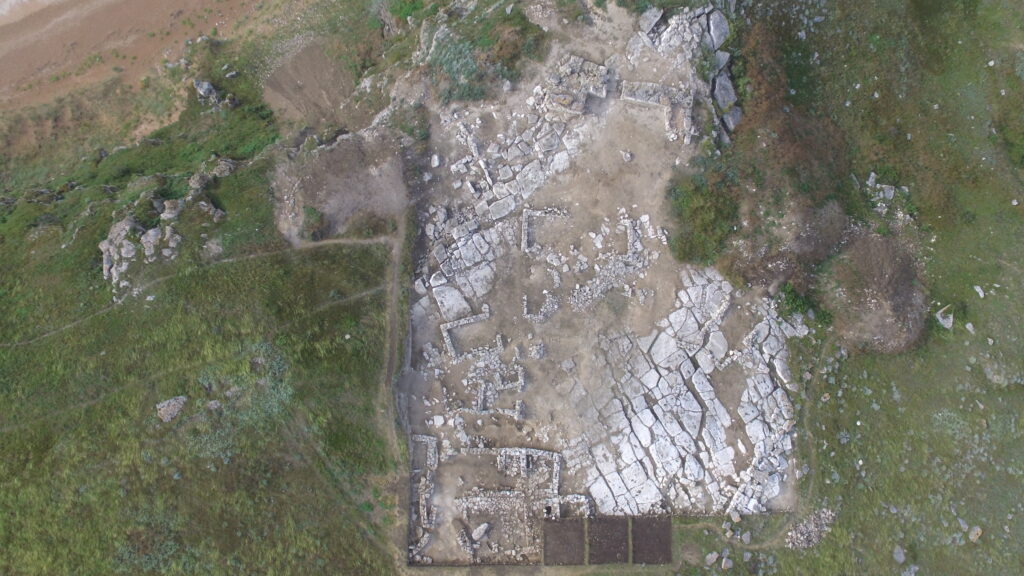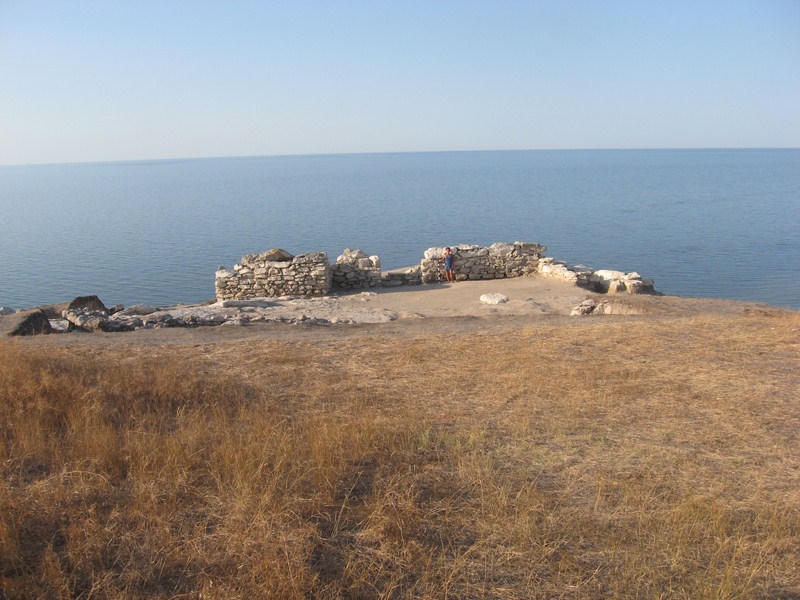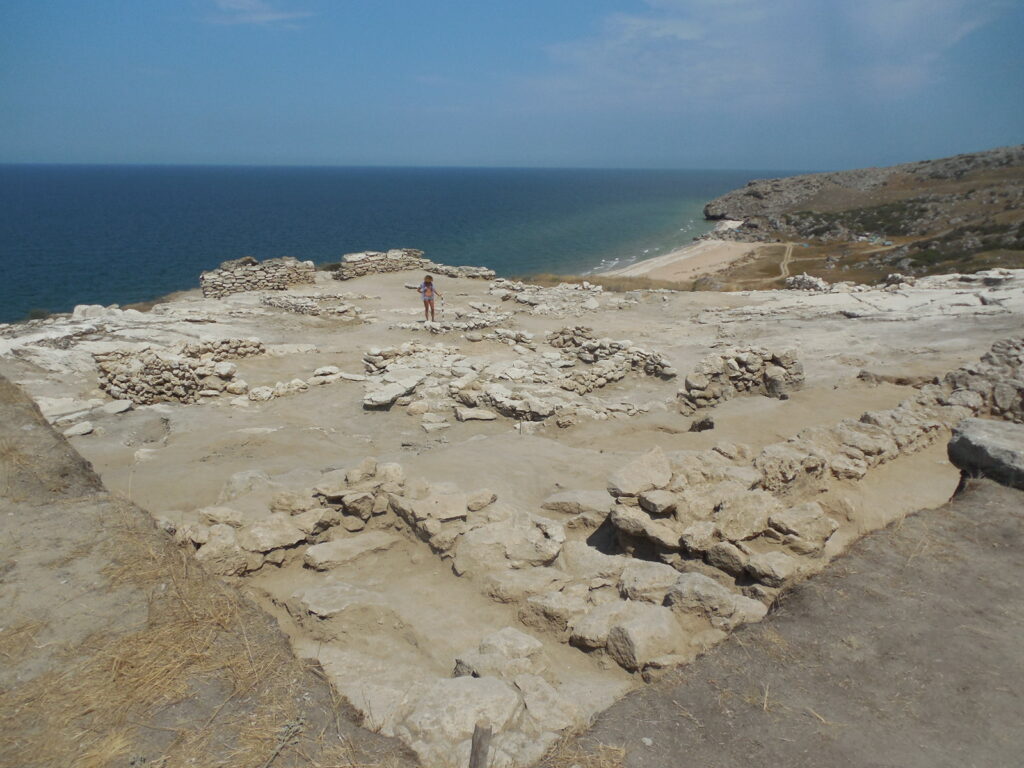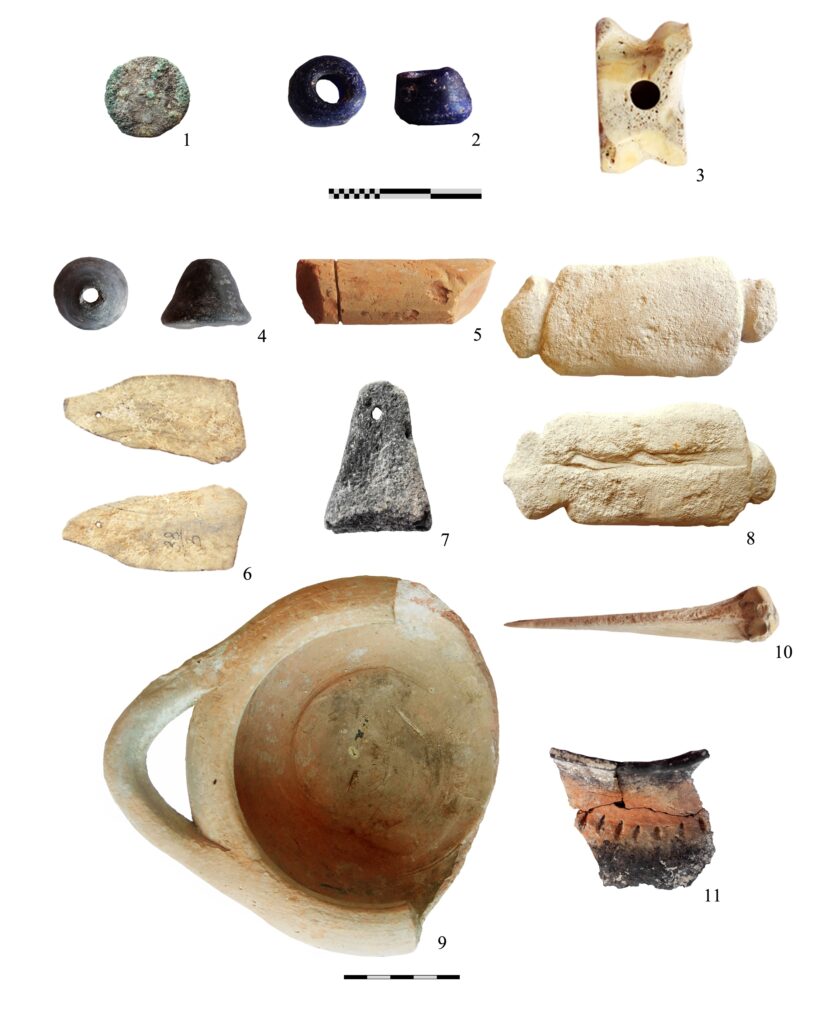Syuyurtash
The settlement of Zolotoye-Vostochnoye (Syuyurtash), occupying an area of 1.5 – 1.8 hectares, lies 4.5 kilometres north-east of the village of Zolotoye in the Leninskii District of the Republic of Crimea. The site is on a plateau 30-40 metres above sea-level with steep inaccessible slopes bordering on the Sea of Azov in the North and a deep gully in the South, down which a stream flows. In the South-West a row of rocky ridges topped by a high hill leads up to it and east of the site there is a small bay containing several ancient wells (Topography, Orthophoto)
Initial reconnaissance and excavations were carried out by I.T.Kruglikova in the early 1950s. She described it as a large and rural Hellenized settlement with a barbarian population and she dated it as having existed between the turn of the 4th century BC and the early 1st century BC [Kruglikova, 1957, p. 127; 1975, p.99].
Between 1989 and 1992 investigations in the western part of the site were carried forward by the East Crimean Expedition of the Institute of Archaeology (affiliated to the Russian Academy of Sciences) led by A.A.Maslennikov: the total excavated area was around 2,000 m². A large defensive wall was discovered stretching along the edge of the plateau, three rows of terraces and part of the main street – 4-6 metres wide – starting from the west gate of the fortified settlement [Maslennikov, 1998, 90-91]. Houses with paved courtyards were arranged in groups along the streets. Small hills of ash were identified in the central and south-western part of the settlement. The date of the settlement’s existence was defined as extending from the third quarter of the 3rd century BC to the turn of the 2nd century BC [Maslennikov, 1998, 100].
In 2010 excavations work began again by a team of the East-Crimean Archaeological Expedition led by A.A.Suprenkov in the north-eastern part of the site (the “Eastern” Trench), on a terrace situated 1-2 metres below the adjacent parts of the site in the South and West.

During the excavations, cultural levels were investigated and also remains of buildings from several different construction periods: the excavated area eventually totalled approximately 2,000 m². In the northern part of the site the large Wall № 1 was cleared which consisted of several built sections. The total length of the excavated wall was 18 metres: in places it was 3.3 metres wide and its maximum height was approximately 2 metres. In the middle of the cleared structure there was a paved passage along it with a width of two metres. On the basis of the fact that no walls adjoining Wall № 1 from the West or East were found and that there were no structures within 5 metres of it, it was assumed that Wall № 1 had not had any defensive role.

Ten metres south of Wall № 1, Structure № 2 was discovered (measuring 10 x 4 metres) but its walls were not joined together. There was a gap on the north and south side roughly opposite the passage leading through the large wall № 1. Next to the break on the north side a pit was discovered and in its in-fill a terracotta figurine of the goddess Cybele was found. To the South of Structure №2 was a section of a partially enclosed space, which was paved and contained a pit measuring 5 x 5 metres, but its function was not clear. Ten metres to the South-West of Wall № 1, stood Structure № 1 (measuring 10 x 3 metres) which consisted of two parts at different levels. The upper part had been erected using roughly worked limestone slabs arranged vertically, while for the stonework of the lower part a more traditional technique was used. Up against the eastern wall of the structure there was another built feature consisting of several pits with a ‘hearth’ at the centre – a ridge of natural soil on which traces of burning could be seen and a flat charred stone leaning up against Wall № 1. The unusual nature of these structures and also the finds of terracotta figurines, the large quantity of ash contained in the levels along with mussel shells, the presence of red pebbles brought in from elsewhere and certain other factors enable us to assume that what we had lighted upon were the remains of buildings erected for sacred purposes [Suprenkov, 2013, 243-248]. We did not succeed in finding direct parallels for such shrines in the North Pontic region and therefore, in subsequent publications, we refer to these structures as socio-sacred. To the South-West and South-East of Structure № 2, Dwelling № 3 was discovered with walls which had not survived in the eastern and southern sections and also Dwellings 4 and 5 (measuring 5.5 x 5 metres and 3.8 x 2.2 metres respectively). The groups of dwellings shared a large paved courtyard measuring 3.4 x2 metres. To the East of these dwellings there were pits for household rubbish.

At some stage in the life of this fortified settlement, the whole of the north-eastern section was no longer inhabited and it came to be covered over with thick layers of ash and rubbish (Level 3). This area was used subsequently for storage purposes. Many pits were dug out in Level 3, which would appear to have been used for storing grain. Material on a mass scale at the site was represented by fragments of amphorae from Sinope and Rhodes, fragments of vessels made from red and grey clay, hand-moulded and black-gloss vessels, pieces of hard clay and animal bones.
In the “Eastern” trench, more than 2,550 profiled fragments of amphorae were found and of these 282 were feet of amphorae. Among these, the overwhelming majority of the finds was from Sinope (69.9%). Feet from Rhodian amphorae accounted for 11.3% of the total, while the rest were from various other centres of production. According to the typology compiled by S.Y.Monakhov, most of the amphorae from Sinope were of the “pithoid” type (dating mainly from the beginning of the 3rd century BC to its third quarter) or the “late” type (dating from the second quarter of the 3rd century BC to the end of the 2nd century BC). A large proportion of the Rhodian amphorae belonged to the Type I – “Villanova “ variant (dating from the period between the end of the second quarter of the 3rd century BC and the end of the 2nd century BC) [Monakhov, 2003, pp. 113, 117-120, 148-152, Plates 81-83 and 102-113].
Tableware and kitchen pottery were represented by 6,813 profiled ceramic fragments. Approximately half of these (43.3%) were wheel-turned red-clay vessels. The small number of other fragments consisted of wheel-turned red or brown-glaze pottery, grey-clay wheel-turned pottery and vessels made of clay from Sinope (a mere 3%).
Black-gloss pottery makes up 4.4% of the remaining vessel fragments, which in most cases were very small. Analysis of finds belonging to this category testify to the fact that, in the second quarter of the 3rd century BC, black gloss was already widely represented in the settlement and the period which followed, up until the end of the 3rd century BC, was that of its most widespread use. In the first quarter of the 2nd century BC there was a reduction in the scale of its use but later, in the second quarter of that century, it began to increase again, until a gradual decline set in once more and lasted until the final stage in the existence of the fortified settlement [Maslennikov, 2017, pp. 312-313].
Individual finds are those of terracotta figurines, lamps, coins (the earliest of these date from 300/250 or 284/275 BC – i.e. from the first half or middle of the 3rd century BC [Maslennikov, 2019, pp. 419-420]), pairs of glass and pottery beads, isolated dipinti and graffiti on amphorae and vessels, some weights from fishing nets and pottery distaffs. Various household objects made of animal bone (borers and so on) were found, metal objects such as a lead seal, a copper buckle and a copper pendant, small objects made from stone (such as a whetstone, a grater stone and others) and projectiles for slings.

Stamps on amphorae will be considered separately.
The collection of amphora stamps from the Zolotoye-Vostochnoye (Syuyurtash) settlement during excavations there in 1955, 1986-1987, 1990-1992, 2005, 2010-2019 consists of 545 imprints in total. Fragments of amphorae from Sinope account for 74% of all the impressions, stamps from Rhodes for 24% and the remainder originated from other centres (Chersonesos, Knidos, Kos and Colchis). A short analysis has been provided in articles by A.A.Maslennikov and A.A.Suprenkov on the periods from which the stamps found in 2010-2017 originated. They date “the re-building of the eastern part of the settlement and the peak of its development” to the second or third quarter of the 3rd century BC [Suprenkov et al., 2017, 261].
Analysis of the stamps from the Zolotoye-Vostochnoye settlement carried out by A.V.Kovalchuk [Kovalchuk, 2020, pp. 220-228] testifies to the fact that the earliest of the stamps from Sinope belong to Groups III and IV (№№ 59, 64, 67, 72, 77, 87, 92 [Conovici, 1998] – a total of only 9 specimens) and can be assigned a date range from 290 to 260 BC. They constitute a small number of the finds which, given the absence of other wide-ranging material from that time, make it necessary to examine them as a kind of early “swathe”. A sharp rise in the number of stamps is to be observed in Period V. Starting with Group Vb, their number rises steadily , reaching its peak in the period 240-220 BC (Group Vc). Almost all the astynomoi from Groups Vb and Vc are represented in the collection. The only exceptions are two magistrates: Mantitheos, son of Protagores (№ 108) and Hyllos, son of Philiskos (№ 135). From the end of the penultimate seventh decade of the 3rd century BC, a similar sharp fall ensues in the scale of imports from Sinope.
The fact that the emergence of the settlement was close to the middle of the 3rd century BC is also confirmed by the date of the earliest stamps from Rhodes. Some of them belong to the so-called stamps “en bouton” – the stamps of Agestratos, Aretakles and Mikythos. The impression of the eponym Polykles belongs to Period Ib (270-246 BC) and the impression of the manufacturer Heroidas would appear to belong to Period Ic (246-235 BC).
It should be noted that material from the nearby rural shrine in a cave dates from 250-230 BC. Of the ten stamps from Sinope already published, three belong to Group Vb [Conovici, 1998], six to Group Vc and one to Group Ve [Fedoseev, 2000, 203-204].
As for the economic activity engaged in by the population of this fortified settlement, it would seem to have consisted mainly in grain cultivation. In part this is suggested by the presence of grain-storage pits. Animal husbandry was also most important in this connection. In the years, during which excavations have been carried out at the fortified settlement, approximately 4,000 animal bones have been found in the ash-and-rubbish levels and 1,862 of them have been identified. Of these 614 bones (33%) have been identified as those of cattle, 499 bones (26.8%) as sheep-goat bones: 68 (3.65%) as goat bones and 128 (6.9%) as sheep bones. Finds of horse bones numbered 212 (11.4%) and pig bones accounted for 177 of the finds (9.5%). Seventy-two bones (3.9%) were those of dogs and five of the bones were human ones (0.27%). Hunting would appear not to have been a major activity: only 7 hare bones were found (0.38% of the total), 2 fox bones (0.1%) and 9 bird bones (0.48%). Fifty-two of the bones were those of fish (2.79% of the total) which could be identified. Among these, five species can be singled out: sturgeon, starry sturgeon, brill, tuna and Black Sea roach – in other words typical fish from the Azov/North-Pontic region in the period under consideration.
Dr. A. A. Suprenkov